Prince Philip: What happens when a Royal dies?
- Published
- comments

The funeral will take place at St George's Chapel at Windsor Castle
Funeral preparations are under way for Prince Philip, the Duke of Edinburgh and the Queen's husband, who died on Friday aged 99.
The funeral will be held at St George's Chapel, in the grounds of Windsor Castle, at 3pm on Saturday 17 April.
It will be televised as well and will begin with a national minute's silence.
You can read all about Prince Philip's life here.
When a member of the Royal Family dies, it is a sad time for their family members, but also for the country they have represented for many years.
Those years of work are something the country remembers, and celebrates, in the days following the death of a member of the Royal Family.
Prince Philip was the longest-serving consort in British royal history, having served as the Queen's consort for 73 years since her coronation in 1952. Consort is the official title given to the Queen or King's partner.
Let's take a look at what will happen next...
What will the Royal Family do?
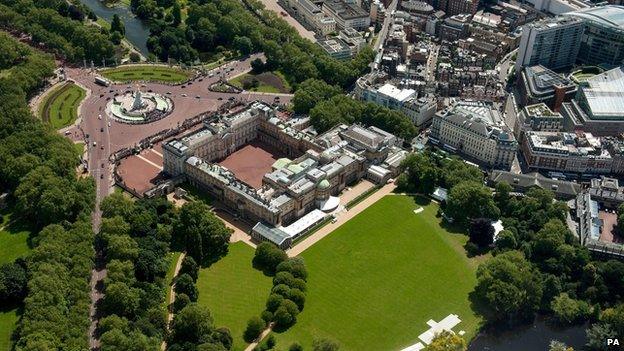
Buckingham Palace where the Duke lived with the Queen
Once a member of the Royal Family has died, Buckingham Palace informs the Prime Minister and a person called the Lord Chamberlain then works with the government to decide when to announce it. The Lord Chamberlain is the Queen's most senior adviser.
Since Prince Philip's death, there have been changes to the Royal Family's immediate work.
The Queen has entered a period of mourning. There will also be no 'Royal Assent' to any business done in Parliament, which means no new laws while the Queen is in mourning.
Buckingham Palace has said the Queen wishes that the Royal Family observe two weeks of Royal Mourning. It will be observed by members of the Royal Family, their households and troops on public duties. During this period, members of the Royal Family will continue undertaking engagements appropriate to the circumstances. Mourning bands will be worn too.
There are also many small details that apply to official royal offices, for example, they will use 'mourning stationery'. This is stationery with a black-edge that is used for all significant announcements and updates about arrangements.
What happens across the country?
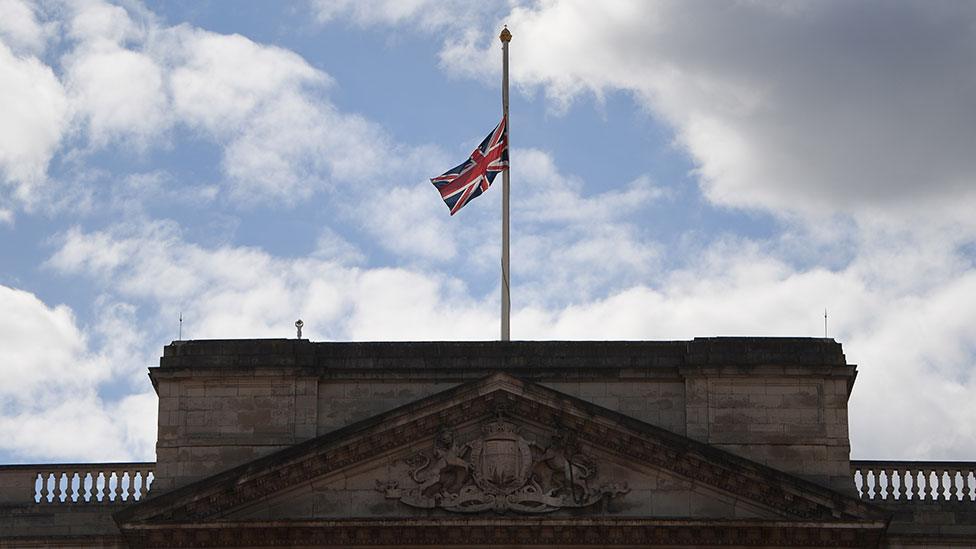
Flags are being flown at half-mast
The country has entered a period of national mourning, which began the moment the royal death was announced on Friday 9 April and will last until, and including, the day funeral of the funeral, Saturday 17 April. National mourning will be observed by all, including British representatives in other parts of the world.
Flags across the country, and at official British buildings across the world, are being flown at half-mast. This will last until the day after Prince Philip's funeral.
The Duke of Edinburgh has also been given gun salutes across the country.
Half-mast means the flag is flown two-thirds of the way up the flagpole, with at least the height of the flag itself between the top of the flag and the top of the flagpole
On flag poles that aren't straight, for example if they are on the side of a building, if they are more than 45 degrees from being vertical, flags cannot be flown at half-mast and the pole should be left empty
When a flag is to be flown at half-mast it should first be raised all the way to the top of the mast, allowed to remain there for a second and then lowered to the half-mast position. When it is to be lowered from half-mast it should again be raised to the top of the mast for a second before being fully lowered
When the national flag is at half-mast other flags should also be at half-mast or should not be flown at all

What will a Royal funeral look like?
Coronavirus restrictions on mass gatherings in England mean the plans for the days leading up to the duke's funeral, and the funeral itself, have been amended.
Prince Philip was involved with preparing the details of his funeral and it will take place at St George's Chapel in the grounds of Windsor Castle.
It is believed Prince Philip wishes to be buried at Frogmore Gardens, where Queen Victoria, who died in 1901, and several other members of the Royal Family, are buried.
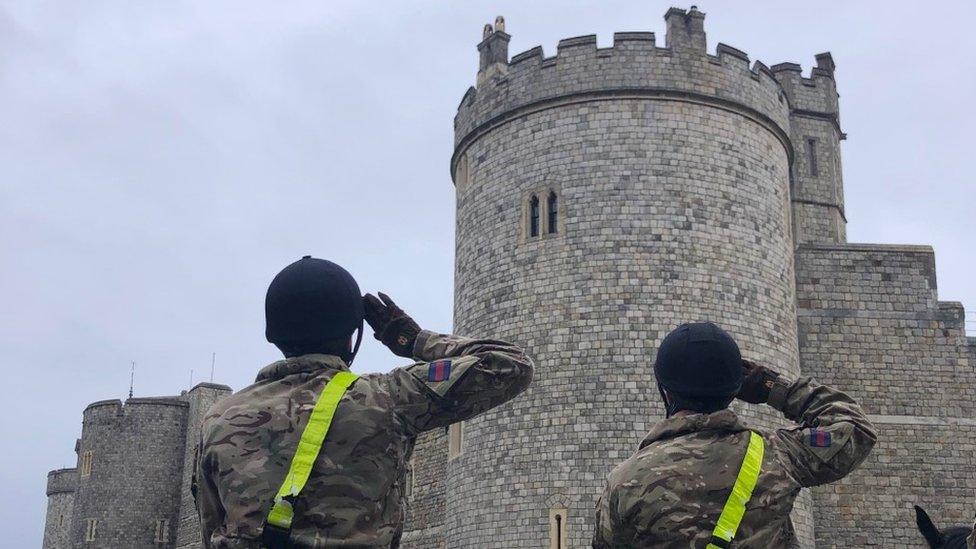
Members of the Household Cavalry gave a salute and observed a two-minute silence opposite Windsor Castle on Saturday morning
In the UK there are different types of official funeral for members of the Royal Family, politicians and distinguished figures.
A state funeral is limited to Sovereigns - Kings or Queens - according to a document provided to MPs explaining the types of official funerals.
However, the Queen can ask for someone to receive a state funeral, as was the case with Sir Winston Churchill, who had been the Prime Minster during world War II. That funeral, in 1965, was Britain's last state funeral.
The other type is called a ceremonial funeral. These are for members of the family who have served with distinction in the military, royal consorts and even the heir to the throne.
The Queen Mother received a ceremonial funeral in 2002, while former Prime Minister Margaret Thatcher was given the same honour in 2013. Diana, Princess of Wales was also given a form of ceremonial funeral despite no longer having the title of Her Royal Highness.
Prince Philip will have a ceremonial funeral in line with his wishes. Immediately before the service there will be a ceremonial procession inside the grounds of Windsor Castle. The armed forces will line the route and members of the Royal Family, including the Prince of Wales, will walk behind the coffin.
The duke's coffin will be draped in his personal flag, known as his Royal Standard. The flag represents elements of his life, from his Greek heritage to his British titles. A wreath of flowers has also been placed on the coffin.
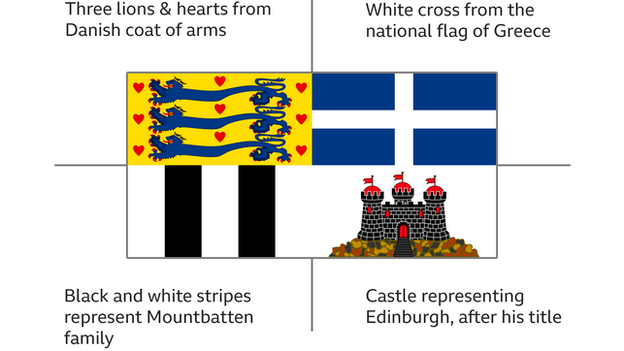
The Royal Standard of Prince Philip represents different elements of his life
Will the duke 'lie in state'?
Normally for a royal death there is a period of 'lying in state'. This is when the coffin is placed in an official building so that members of the public can pay their respects.
That period of time is not set out, but is normally several days. Winston Churchill lay in state for three days, for example, during which time more than 300,000 people came to pay their respects, often waiting several hours for their moment to say goodbye.
Due to coronavirus restrictions and in line with Prince Philip's own wishes, there will be no 'lying in state' period as part of his funeral. Instead he will lie at rest in Windsor Castle.
On the day of the funeral, the coffin will be moved a short distance to St George's Chapel for the service.
The College of Arms, which helps to organise state occasions, said the plans for the duke's funeral were "in line with custom and with His Royal Highness's wishes".
Who will attend Prince Philip's funeral?
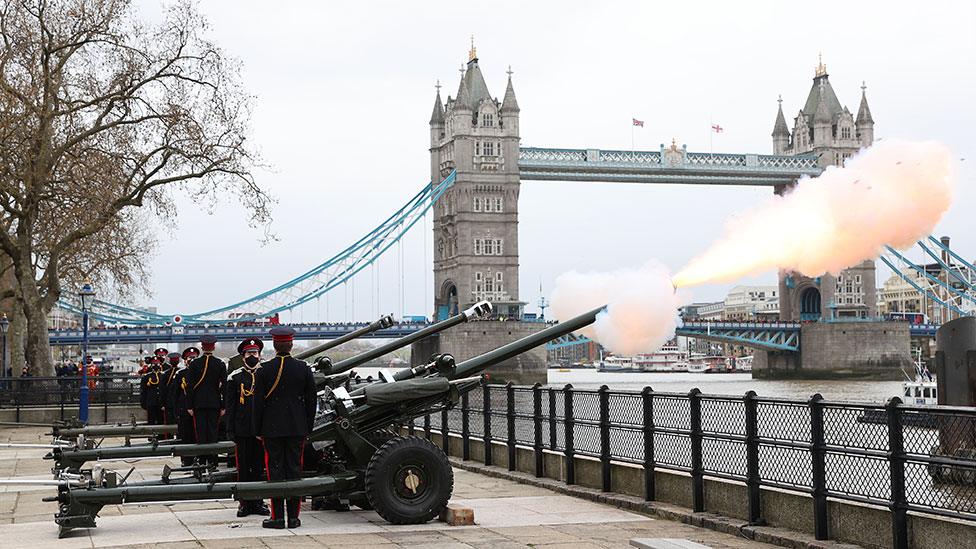
A gun salute takes place in London
Under earlier arrangements thousands of people would have been expected to gather in London and Windsor.
Hundreds of members of the armed forces would have lined the streets in honour of the duke, alongside thousands of police officers.
But as a result of coronavirus measures, organisers have been working on different plans which will avoid any mass gatherings.
Only 30 people - expected to be the duke's children, grandchildren and other close family - can attend the funeral at St George's Chapel, Windsor. Details of who will attend will be released on Thursday.
However it has been said that Prince Harry, the Duke of Sussex, will attend the funeral. He's currently living in the US with his wife and has not returned to the UK since stepping down as a senior royal last year. The Duchess of Sussex, who is pregnant with their second child, has been advised by her doctor not to travel, Buckingham Palace said.
How can the public pay their respects?
Members of the public have been asked not to try to attend any of the funeral events, in line with public health advice.
The Royal Family has also asked people not to leave flowers and tributes at Royal residences.
On the Royal Family website, members of the public are asked to consider making a donation to a charity instead of leaving floral tributes in memory of the duke. An online book of condolence is also available for the public to post their personal tributes.
A plaque that was displayed outside Buckingham Palace, announcing the duke's death, was later removed because of concerns it would attract crowds.
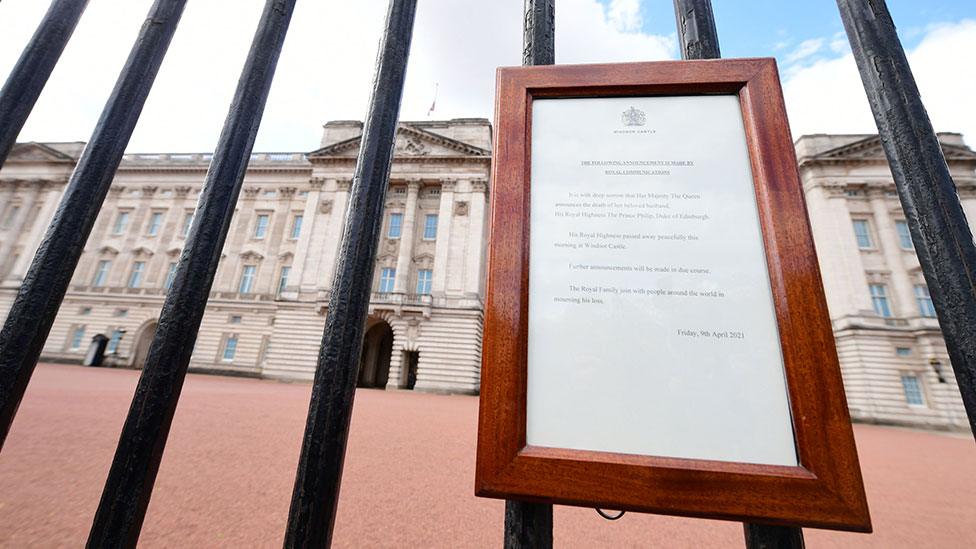
Who takes over Royal Duties?
Prince Philip was involved with almost 800 charities and organisations during his life. When he retired in 2017 he ended his involvement with them, some of whom he had worked with for several decades.
Since his retirement, other members of the Royal Family have stepped in to some of those charity positions, and people like Prince Charles and Prince William have accompanied the Queen to more official engagements.
What happens in other parts of the world?
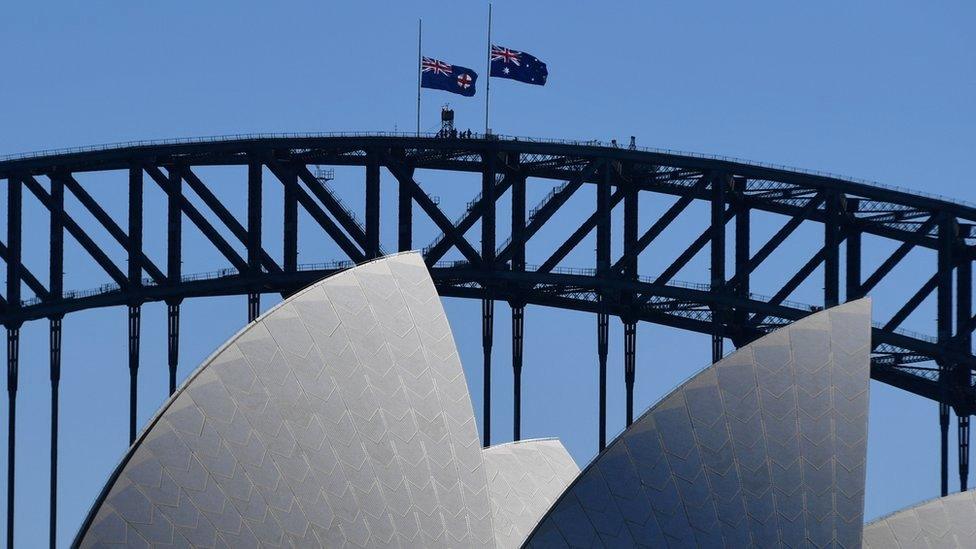
Australian flags were flown at half-mast on the Sydney Harbour Bridge in tribute to the duke
A death in the Royal Family is an international event. The family are recognised and respected across the world.
For some countries there are official responses. The Commonwealth realm includes nations like Australia, Canada and New Zealand. They are countries that have the Queen as head of state.
Following the announcement of Prince Philip's death, the prime ministers of Australia and New Zealand announced flags would be lowered to half mast in their countries, and paid their own tributes to the duke.
However, other countries will also reflect on the sad news. Leaders from around the world have sent their tributes and condolences to the Royal Family.
- Published10 April 2021
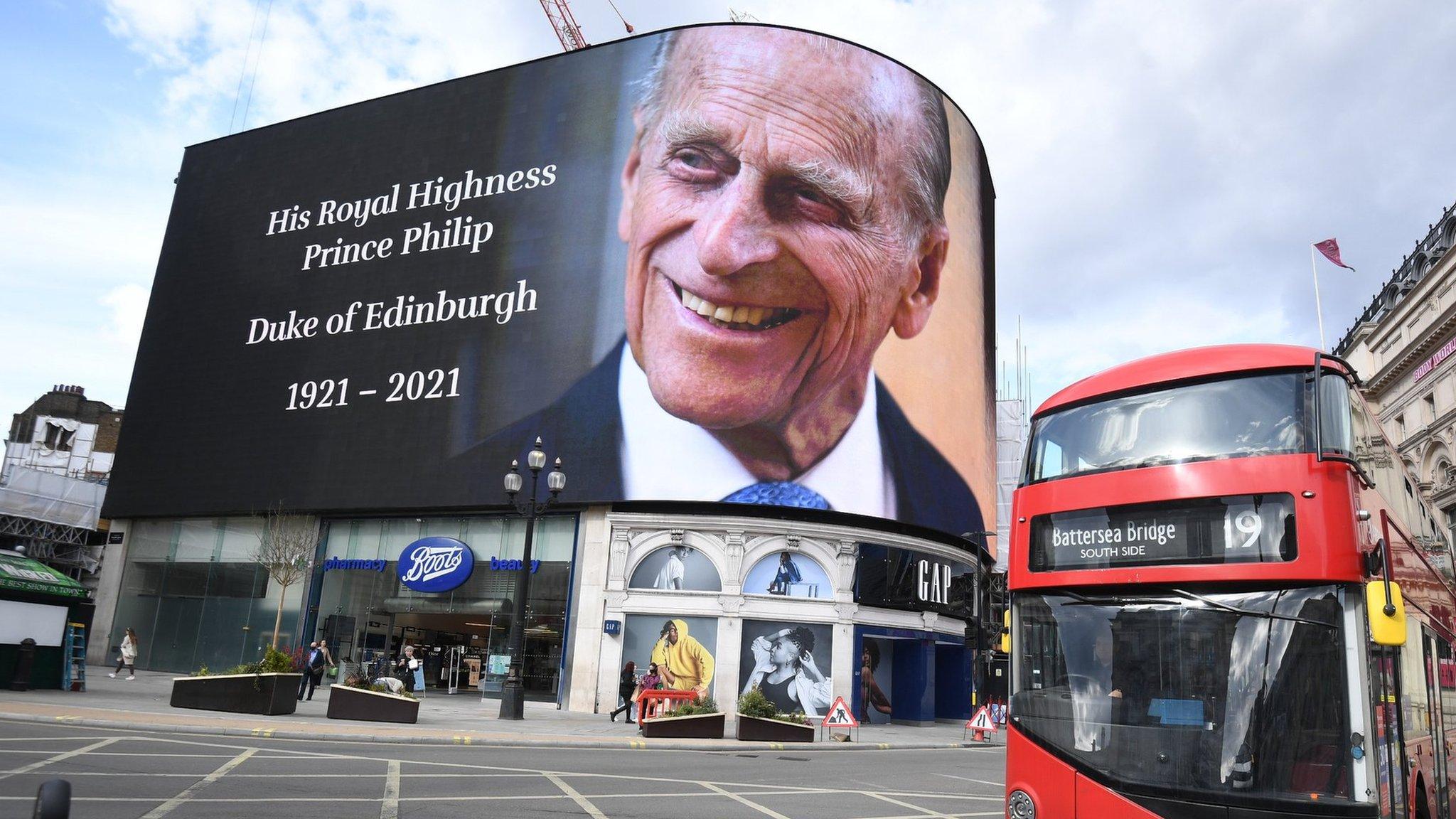
- Published9 April 2021

- Published9 April 2021
